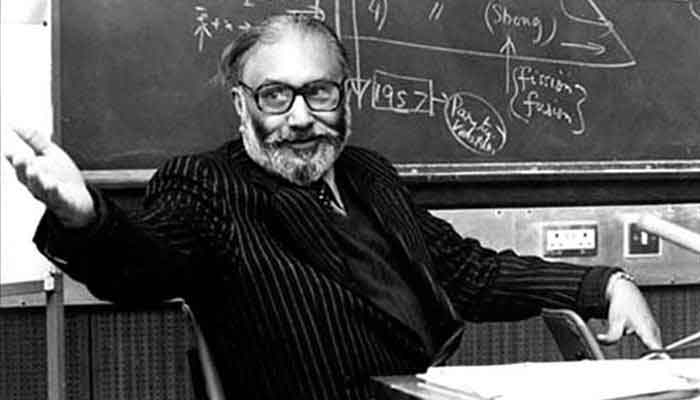A tribute to Dr Salam
Last week was the Pakistani Nobel Laureate Abdus Salam’s 93rd birth anniversary and since I was reading about his work I decided to write a column about science today.
Whenever Dr Salam’s name comes up in Pakistan, we discuss his religious beliefs but not his scientific contributions. The fact is that he was an outstanding scientist and has rightly earned respect in international academic circles for his seminal contribution to particle physics. His religious beliefs are irrelevant to his scientific achievements.
Now a little science to introduce you to a portion of Salam’s work: everything we interact with – from the air we breathe to the food we eat to the cement used in our homes – is made up of atoms, the smallest, indivisible part of matter. The iron grill in our home is made up of billions of iron atoms that make the element iron. The gold ring you’re wearing is made up of billions of gold atoms that make the element gold. However, the water we drink is a combination of two elements – oxygen and hydrogen – and is formed when two atoms of hydrogen combine with one atom of oxygen to form one molecule of water.
All atoms, whether those of iron or oxygen, are composed of a central nucleus (containing protons and neutrons) that is orbited by negatively-charged electrons. The electron orbit is so far away from the nucleus that an atom is mostly empty space. For example, if a nucleus were the size of a cricket ball the electron orbit would be 2.25 miles away.
The electron was first discovered in 1897 by the English scientist Joseph Thomson. Then in 1914, New Zealander Ernest Rutherford discovered the positively-charged proton. His student James Chadwick discovered the neutron in 1932.
An American physicist Murray Gell-Mann theorised that protons and neutrons are themselves made up of three quarks each. Hence, we can say that quarks along with electrons and similar particles are the basic building blocks of nature.
Nature has four fundamental forces: first, the strong nuclear force that keeps quarks confined within protons and neutrons and also binds protons and neutrons to form the atomic nucleus; second, the electromagnetic force that makes negatively-charged electrons orbit positively-charged nucleus; third, the weak nuclear force that causes radioactivity and converts neutrons to protons; and, fourth, gravity that makes matter attract each other and keeps large masses together.
Physicist James Maxwell came up with the formulation for the electromagnetic force in 1873. The first successful theory of the strong nuclear force was put forth by the Japanese physicist Hideki Yukawa in 1935.
The third fundamental force, the weak nuclear force, was worked on by the distinguished Italian physicist Enrico Fermi and brilliant American physicists Richard Feynman and Maurice Gell-Mann. But it was our own Professor Abdus Salam who, along with Steven Weinberg working independently, correctly formulated and predicted that the weak force and the electromagnetic force were different manifestation of the same force at lower temperatures. And indeed it was experimentally confirmed some years later that, at high enough temperatures, these two forces are the same.
Gravity was first ‘discovered’ by the greatest scientist of all time, Sir Isaac Newton in 1760. (Newton also invented calculus. His German contemporary Gottfried Leibniz also independently invented calculus but Newton, not a particularly nice man, did all he could to deny Leibniz any credit for his invention. No controversy however exists regarding the father of algebra, Persian scholar Muhammad ibn Musa al-Khwarizmi – who in the ninth century wrote his book ‘Kitab al-mukhtasar fi hisab al-jabr wal-muqabala’ in Baghdad. The word algebra is derived from the word al-Jabr).
Newton’s theory of gravitation, while path-breaking, was not completely accurate and it was left to the great German-Swiss physicist, Albert Einstein, to give an accurate theory of gravity. Einstein’s theories of relativity were revolutionary and suggested that time and space (or one’s position in space) are both relative, that we live in a four-dimensional world with three spatial and one temporal dimensions, that the faster you move through space the slower you move through time, meaning that a person who travels close to the speed of light will age much more slowly than a person not moving as fast, and that gravity causes massive bodies to actually curve space. Einstein also discovered the universal speed limit, which is the speed of light, and gave us a formula that converts mass into energy.
Around the same time that Einstein was working on his theory of gravity, many European scientists including Max Planck, Werner Heisenberg, Wolfgang Pauli, Niels Bohr and Einstein himself were working on a new theory called the quantum theory or quantum physics. It says that particles such as electrons behave both like discrete particles as well as waves. These theories gave rise to some unintuitive results, such as the fact that when travelling from point A to B, an electron doesn’t just travel through the straight path but simultaneously travels on all possible paths. Or that if we know the exact speed of a particle we can’t know its location. Or that electrons orbiting a nucleus in an atom can’t just orbit anywhere but can only do so at discrete intervals.
Einstein’s theory of gravity has been very successful in predicting the large-scale structure of the universe and numerous experiments have supported this theory. Equally successful has been the quantum theory predicting the behaviour of fundamental particles such has electrons etc. Countless experiments have supported the quantum theory.
The only trouble is that both these theories are incompatible at some level. Scientists are, therefore, busy finding a new theory that encapsulate both these theories but isn’t internally contradictory. One such candidate is string theory which posits all particles as tiny one-dimensional vibrating strings. String theory also hypothesises that the world we live in is made up of not three but ten or more dimensions. So far, string theory has not had any experimental success so it is not accepted as a valid explanation of physical phenomenon.
I wrote the names of scientists here purposely to give readers a flavour of the paucity of Muslim or Pakistani names among the discoverers of natural phenomena. And what’s worse is that even 71 years after Independence we are not on the right track yet.
While brilliant scientists around the world are studying how electrons can behave as both waves and particles, and how we can tell what distant stars are made of by studying the wavelength of light emanating from those stars, we have 3.5 million kids in madressahs to whom we teach no science. And we have millions more in fancy English-medium or government-run Urdu-medium schools where rote memorisation is the method of choice and where kids are mostly taught to remain incurious about the natural world around us.
Why is Pakistan poor? Why is our life expectancy up to 15 years less than Japan? Why do we have such high infant mortality? Because we don’t produce enough (or any) Newtons, Einsteins, Feynmans and Salams.
The writer has served as federal minister for finance, revenue andeconomic affairs.
Twitter: @MiftahIsmail
-
 Simu Liu Reveals How His Family Treated Him After He Started Acting
Simu Liu Reveals How His Family Treated Him After He Started Acting -
 Gwyneth Paltrow Mourns Valentino As She Calls His Death 'end Of An Era'
Gwyneth Paltrow Mourns Valentino As She Calls His Death 'end Of An Era' -
 Three-year-old Allegedly Tortured, Killed During Exorcism In California Church
Three-year-old Allegedly Tortured, Killed During Exorcism In California Church -
 Blake Lively Gushes She And Ryan Reynolds Are 'partners In Everything'
Blake Lively Gushes She And Ryan Reynolds Are 'partners In Everything' -
 Teyana Taylor Reflects On Co-parenting Journey With Ex Iman Shumpert
Teyana Taylor Reflects On Co-parenting Journey With Ex Iman Shumpert -
 Blake Shelton Recalls Being 'nervous Wreck' On Adam Sandler Film
Blake Shelton Recalls Being 'nervous Wreck' On Adam Sandler Film -
 Prince Harry's Lawyer Tells Court Daily Mail Complicit In Unlawful Acts
Prince Harry's Lawyer Tells Court Daily Mail Complicit In Unlawful Acts -
 Meghan Markle Named In Epstein Files With Ghislaine Maxwell?
Meghan Markle Named In Epstein Files With Ghislaine Maxwell? -
 Drunk Driver Tries To Snatch San Diego Deputy’s Gun During Chase
Drunk Driver Tries To Snatch San Diego Deputy’s Gun During Chase -
 After Surgery, Piers Morgan Reminded Of His Remarks About Meghan's Father's Hospitalization
After Surgery, Piers Morgan Reminded Of His Remarks About Meghan's Father's Hospitalization -
 Idris Elba Gets Honest About Managing Real-life Hijack Situation
Idris Elba Gets Honest About Managing Real-life Hijack Situation -
 Royal Family Buries King Charles' Cousin
Royal Family Buries King Charles' Cousin -
 Elizabeth Hurley Faces An Impossible Choice As Son Damian, Beau Billy Ray Cyrus Clash
Elizabeth Hurley Faces An Impossible Choice As Son Damian, Beau Billy Ray Cyrus Clash -
 Rare Pokémon Cards Worth $100k Stolen In New York Shop Robbery
Rare Pokémon Cards Worth $100k Stolen In New York Shop Robbery -
 Chevy Chase Shares Disappointment After 'SNL50: The Anniversary Special' Snub
Chevy Chase Shares Disappointment After 'SNL50: The Anniversary Special' Snub -
 Samuel L. Jackson's Old Movie Found New Life: Here's How
Samuel L. Jackson's Old Movie Found New Life: Here's How




